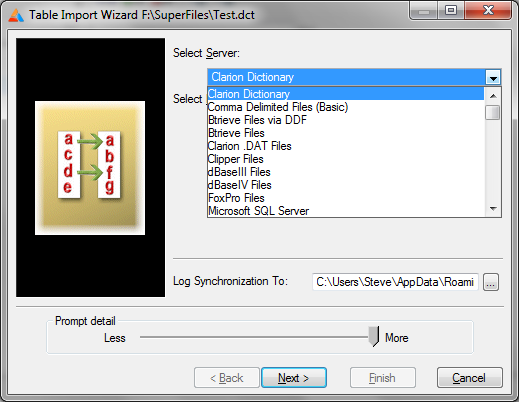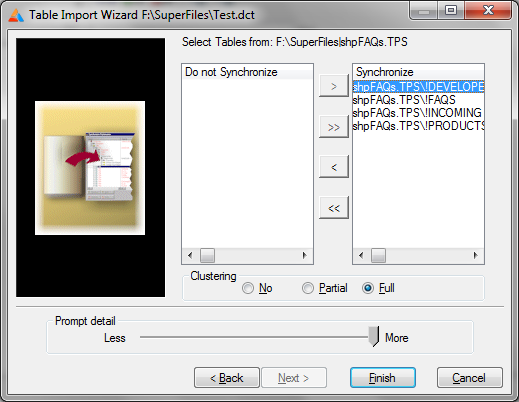SuperFile to DCT
by StevenP
A few years ago, I investigated Topspeed “SuperFiles.” I wrote about their internal design, how to make them in a dictionary, how to use NAME() with them and how to create a new SuperFile out of existing single table files.
One thing I forgot to investigate; one thing I never thought I'd need to know. Now I do. How do I make a dictionary from an existing TPS SuperFile (or make the appropriate dictionary entries in an existing dictionary)? I am not talking about a situation in which I've lost the dictionary and need to re-create it – shame on me if I don't have a backup nearby! I am talking about a situation in which I inherit a SuperFile but there is not and never has been a dictionary (let's say my predecessor was a hand coder, and leave it at that).
Of course, I can locate the file spec in the source files, make a dictionary and manually type in everything I need.
Similarly, suppose I don't have any .APPs or .CLWs, I can get the file layout information from TopScan (File | File Layout... and get the information from the pop up screen or, even, print it out).
Right. But I don't think so. If all else fails, perhaps … but only if all else fails.
Clarion, ever since there has been a separate dictionary (i.e., Clarion Database Developer, for DOS), has offered an option to import an existing file into a dictionary. In CDD, importing an existing file into a DCT used to be very easy: File | Import, navigate to the file, select it, bada bing bada boom, all done. In Windows, it is not so straightforward. Clarion now invokes “The Synchronizer.” And I have never mastered the Synchronizer (in other words, it gives me a lot of trouble – I blame it on SoftVelocity not making the prompts self-documenting and actually expecting me to understand something).
Additionally, there is the question “Will the Synchronizer handle a SuperFile?” Let's find out.
Step 1
The first step is to locate the SuperFile. For this exercise, I selected a four table SuperFile, the SuperFile that drives my WebBuilder FAQ app:
Figure 1: shpFAQ.TPS
Step 2
Next, open or create, as necessary, the target dictionary. Now I'm ready to see if I can import a SuperFile.
Step 3
Click the down arrow on the “Add Table” button in the Dictionary Editor:
Figure 2: Beginning the file import process
This calls the Synchronizer window.
Step 4
This is where I've always run into trouble. I've never quite grasped what “Select Server” referred to. Pressing the down arrow produces a drop box:
Figure 4: “Select Server” dropped
“Clarion Dictionary” is the default selection but clearly not helpful in the current exercise. Scrolling down the list reveals something much more useful:
Figure 5: TopSpeed file as “Server”
The remaining prompts are not relevant for the import of a file, so I press “Next.” So, it appears that “Select Server” is “source.” If so, the next window:
Figure 6: Select source
must be for selecting the files to import. The drop list is useless (empty, as I recall) so I pressed the ellipsis. This produced the standard Windows file dialog. So, I selected the SuperFile:
Figure 7: Source TPS file selected
Step 5
Et violá, a list of the tables inside the SuperFile!
Figure 8: Select file(s)/tables to import
Press the “select all” (“>>”) button and
Figure 9: Files/tables selected for import
Step 6
Time to celebrate, all of the tables show up in the dictionary:
Figure 10: Dictionary after import
Step 7
Every time I ever imported a file into a CDD dictionary, the FullPath Name prompt (NAME() attribute) contained the fully qualified DOS specification of the source file:
Figure 11: Table properties
This is almost never correct and needs to be edited. I might want a variable in the NAME() attribute, I might want a standard string (“shpFAQs\!DEVELOPERS” was in the dictionary which originally created the SuperFile for this oversize). But I almost never want the fully drive and path in the NAME().
Conclusion
SuperFiles really are just ordinary TPS files. Or, as I previously demonstrated, all TPS files are actually SuperFiles and everything I can do with a single-table-TPS file, I can do with a multi-table-TPS file.




.png?version=2&modificationDate=1383061319651&cacheVersion=1&api=v2)




